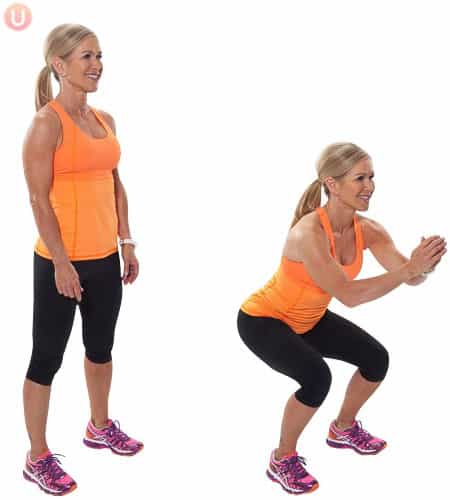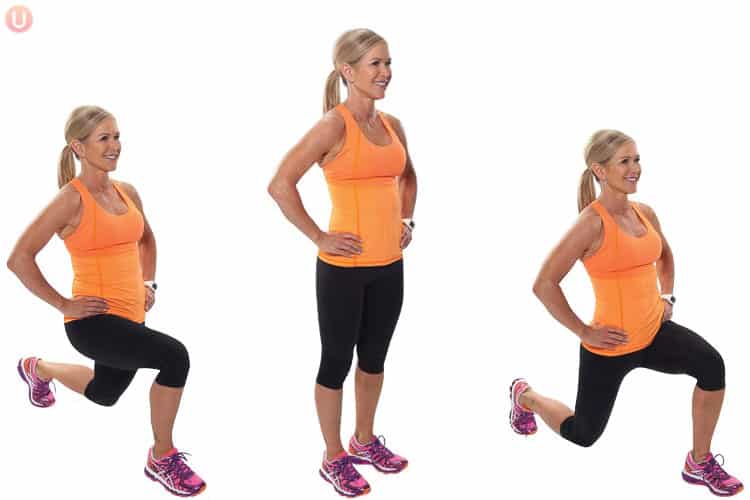This post contains affiliate links. Please see our disclosure policy.
Jumping rope can bring back memories of childhood and hanging out on the playground. But jumping rope is also a great cardio workout for adults. It’s inexpensive compared to a bike or a treadmill. And it helps to improve your heart health, shed calories, and improve coordination all at the same time.
If you’re a beginner, we’ve got everything you need to know in this article, from what jump rope to use to two great beginner jump rope workouts.
So grab your jump rope and jump in!
Health Benefits Of A Jump Rope Workout
There are so many health benefits that come with a jump rope workout. Check them out below!
1. Improves Heart Health
Jumping rope is a great cardio exercise. The longer you go, the more you’ll rev that heart rate and jumping rope for cardio is fun too!
2. Can Aid Weight Loss
Jumping rope is a great way to burn calories. In fact, compared to jogging, jumping rope actually burns more calories! This means that you can absolutely jump rope for weight loss.
3. Improves Coordination
Because you’re using your legs and arms at the same time, jumping rope requires synchronicity of movement between different body parts. Practicing this and jumping rope regularly, it will improve your balance, agility, and coordination.
4. Reduces Injury
Jumping rope can actually reduce the likelihood of injury, particularly when it comes to foot and ankle injuries. The repetitious jumping movement creates a lightness on your feet and agility that can translate into reduced injury in other activities.
5. Portability
Since a jump rope is small, lightweight, and can be folded into a small loop, it’s a very portable piece of fitness equipment. Pack it in your suitcase for a great workout while away, keep one in your gym bag, or even your purse!
6. It’s Fun!
Jumping rope is one of my favorite healthy activities for kids in addition to being a great workout, because it’s fun! Include kids or grandkids to bring a smile to your face while you exercise.
How To Do The Basic Jumps
Squeeze the biceps in order to rotate the jump rope in a forward (or backwards) motion. Believe it or not, the upper arm and forearm grip plays a huge role in jumping rope.
Relax the shoulders away from the ears, keep the elbows pinned in closer to the body, and rotate the rope with the wrist.
The forearm grip and bicep squeeze will be secondary movers to the wrists controlling the rotation of the rope.
Do one two-footed bounce per rotation of the jump rope. It is recommended that by saying the word ‘jump’ out loud while jumping rope, it will help you get into the proper rhythm. It might sound silly at first, but as you hear the rope hit the ground, say jump, and it will remind your body to simply jump off the ground at the right time.
Now it’s time to master the two-footed basic jump rope! Grab your rope, engage your core, and keep those elbows in tight! You’ve got this!
Best Jump Rope To Use
When it comes to using a jump rope for your workouts, your basic jump rope will do. The great news here is that you don’t need anything fancy! And while some fitness equipment can be a little spendy, a jump rope is a very economical option.
The jump rope I recommend is Amazon’s best-selling jump rope. This skipping rope is with two soft handles made of foam material, feeling more comfortable for the grip of the hand.
If you want a higher technology jump rope, this digital weighted jumping rope with a calorie counter and adjustable speeds can also be the way to go.
Two Jump Rope Workouts To Burn Calories
The first is for beginners looking for something a little simpler, and the second is a jump rope HIIT workout involving some strength work if you’re looking to up the ante.
1. A Beginner Jump Rope Workout
What you’ll need: A jump rope adjusted to the correct height.
Start off with a basic jump step. Either skip over the rope or only one two-footed bounce per rotation of the jump rope.
When you are learning to jump rope, you may miss a few jumps. If so, just start again, that is expected. Just do your best to keep moving and pay attention to your heart rate.
As this workout gets easier the more you do it, try to increase your tempo as you go!
- 20 seconds of jumping followed by 30 seconds of rest
- 20 seconds of jumping followed by 30 seconds of rest
- 30 seconds of jumping followed by 30 seconds of rest
- 30 seconds of jumping followed by 30 seconds of rest
- 45 seconds of jumping followed by 30 seconds of rest
2. 15-Minute HIIT Jump Rope Workout
What you’ll need: A jump rope adjusted to the correct height.
Directions: This jump rope HIIT workout is a high-intensity interval-style workout that alternates between cardio jump roping and bodyweight strength training moves.
In this jump rope workout, you’ll do 1 minute of jumping rope followed by 1 minute of strength training exercises.
Go hard on the “workout” and use your 30 seconds of “rest” to recover.
This workout will take approximately 15 minutes. (If you need extra recovery time, feel free to take it.)
Interval 1:
Jump rope 1 minute / rest 30 seconds
Basic squats 1 minute / rest 30 seconds

- Stand tall with your feet hip-distance apart. Your hips, knees, and toes should all be facing forward.
- Bend your knees and extend your buttocks backward as if you are going to sit back into a chair. Make sure that you keep your knees behind your toes and your weight in your heels.
- Rise back up and repeat.
Repeat
Interval 2:
Jump rope 1 minute / rest 30 seconds
Pushup T 1 minute / rest 30 seconds

- Begin in a plank position with hands below shoulders, legs long and abdominals tight so your body is in a straight line.
- Bend elbows, lowering chest to the ground, keeping gaze in front of fingertips.
- Press the chest back to the start position and open your right hand and hip to the ceiling so you end up in a side plank position. Feet stay staggered and legs long.
- Rotate right hand back to start position and repeat exercise, this time opening the left hand into the side plank. This is one repetition.
Repeat
Interval 3:
Jump rope 1 minute / rest 30 seconds
Alternating forward lunges 1 minute/rest 30 seconds

- Stand tall with your feet hip-distance apart.
- Take a large step forward and lower your body toward the floor. Both legs should be bent at a 90-degree angle at the bottom of the lunge. Push off the front leg to rise back up to start, and repeat on the other side.
Repeat
Interval 4:
Jump rope 1 minute / rest 30 seconds
Plank to single-arm reach 1 minute/rest 30 seconds

- Begin in a plank position with your shoulders over your wrists and your body in a straight line.
- Raise your right arm and hold keeping your abs tight. Repeat on the other side.
Repeat
Interval 5:
Jump rope 1 minute / rest 30 seconds
Full sit-ups 1 minute / rest 30 seconds

- Start with knees bent and feet on the mat. Arms are crossed and resting on the chest.
- Bring chin to chest and flex, the head, neck, and torso off the mat coming to a seated position then return back down with control.
Repeat
FAQ’s For Starting Your Jump Rope Workout
How often you jump rope depends on your fitness level and personality.
If you are already used to higher-impact exercise and a high level of fitness, you may want to add a jump rope session 3-4 times a week. Even a 10-minute session will push your heart rate up quickly.
If you are a beginner when it comes to jumping rope, you may want to start with 1 or 2 sessions a week and begin with 30 seconds of jumping followed by 30 seconds of rest. Just go for 3-5 minutes. Slowly start working toward jumping for a full minute, followed by 30 seconds of rest. Work your way up to a full 2 minutes.
Stand on the midpoint of your rope. Place both of your feet on the midpoint of the rope (just a few inches apart).
Pull the rope taut on both sides.
Measure where the handles reach to your armpits.
Adjust the length of your rope accordingly.
Trim the excess wire or knot it depending on your rope.
Before mindlessly getting started with simply ‘jumping rope,’ it is crucial to engage the entire body. Engaging the core tight will protect your low back as you jump each rotation. With a slight tuck of the tailbone and soft micro-bend of the knees, this will take the impact out of the low back and take away those aches and pains of jumping rope.



I will try this. I want to make skipping rope part of my workout routine but wasnt sure how to form an exercise pattern.